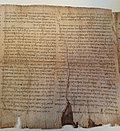Origen
Origen (or Origenes, also Origen(es) Adamantius) was an early Christian scholar. He lived in Alexandria in the 3rd century. He was born in the year 185 or 186, and proably died around the year 254. Today, he is regarded as one of the Church Fathers, but not as a Saint. This is probably because he had some ideas, which were declared to be false later on. These ideas included that the human soul existed before conception, and entered the human body before birth (generally known as pre-existence). Another idea was that of the souls entering a different human body after death. A third idea, called Apocatastasis, is that the reign of god would be restored when the world ends. These ideas were discussed by church fathers, but it was decided that they were false beliefs.[1] The Ecumenical Council of Constantinople in 453 CE posthumously excommunicated Origen, and the 2nd Council of Constantinople in 553 CE declared apocatastasis as heresy.[2] However, in recent years the idea has found some reconsideration[3] especially among Restorationist Christian groups.
His writings are included in the general collection of early Church Fathers.[4][5] However, unlike many church fathers, Origen was never canonized by the Catholic Church, because some of his teachings (for example, that every man and woman, and even the devil and his demons, would ultimately be saved) directly contradicted the teachings and actions of the apostles.
Origen wrote about many branches of theology, including textual criticism, biblical exegesis and hermeneutics, philosophical theology, preaching, and spirituality. Some of his teachings, however, quickly became controversial. Notably, he frequently referred to his hypothesis of the pre-existence of souls. In the beginning all intelligent beings were united to God. In his writingas, Origen also considered the possibility, that in the end all beings, perhaps even the arch-fiend Satan,[6] would be reconciled with God in what is called the apokatastasis ("restitution").
Origen saw the Son of God as subordinate to God the Father. Even though this view of the Trinity was common at the time, it became controversial during the Arian controversy of the fourth century. A group who came to be known as Origenists, and who firmly believed in the preexistence of souls and the apokatastasis, were declared anathema in the 6th century. This condemnation is attributed to the Second Ecumenical Council of Constantinople (553), though it does not appear in the council's official documents.[7]
Origen Media
While in Jericho, Origen bought an ancient manuscript of the Hebrew Bible which had been discovered "in a jar",[8] a discovery which prefigures the later discovery of the Dead Sea Scrolls in the twentieth century.[8] Shown here: a section of the Isaiah scroll from Qumran.
Julia Avita Mamaea, the mother of the Roman emperor Severus Alexander, summoned Origen to Antioch to teach her philosophy.[9]
Diagram showing the inter-relationship between various significant ancient versions and recensions of the Old Testament (some identified by their siglum). LXX here denotes the original septuagint.
Greek text of Origen's apologetic treatise Contra Celsum, which is considered to be the most important work of early Christian apologetics[10][11]
The Birth of Esau and Jacob (c. 1360–1370) by Master of Jean de Mandeville. Origen used the Biblical story of Esau and Jacob to support his theory that a soul's free will actions committed before incarnation determine the conditions of the person's birth.[12]
References
- ↑ Hans Urs von Balthasar, Origen of Alexandria: Spirit and Fire: A Thematic Anthology of His Writings
- ↑ "Internet History Sourcebooks". sourcebooks.fordham.edu.
- ↑ Mario Baghos, Reconsidering Apokatastasis in St Gregory of Nyssa's On the Soul and Resurrection and the Catechetical Oration Phronema, VOL. 27(2), 2012, 125-162. Baghos traces the resurgence of the idea in the twentieth century, and shows that apokatastasis in the Nyssen did not equate unequivocally to universal salvation, a common belief in contemporary scholarship.
- ↑ For instance, Pope Benedict XVI, in his Wednesday catecheses from March 7, 2007, to June 25, 2008, on the Church Fathers, devoted two talks to him.
- ↑ Benedict XVI, General Audience, St Peter's Square, Wednesday 25 April 2007, Origen of Alexandria: life and work. [1]
- ↑ Patrides, C. A. (October–December 1967). "The salvation of Satan". Journal of the History of Ideas. 28 (4): 467–478. doi:10.2307/2708524. JSTOR 2708524. reprinted in Patrides, C.A. (1982) [1967]. "'A principle of infinite love': The salvation of Satan". Premises and motifs in Renaissance literature. Princeton, New Jersey: Princeton University Press. JSTOR 2708524.
- ↑ Philip Schaff, ed. (1994) [1885]. "The Anathemas Against Origen". Nicene and Post-Nicene Fathers: Series II, Volume XIV (The Seven Ecumenical Councils). Peabody, Massachusetts: Hendrickson Publishers. ISBN 1-56563-116-1.
- ↑ 8.0 8.1 McGuckin 2004, p. 10.
- ↑ Olson 1999, p. 101.
- ↑ Olson 1999, pp. 101, 103.
- ↑ McGuckin 2004, pp. 32–34.
- ↑ Greggs 2009, pp. 58–59.






